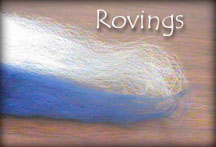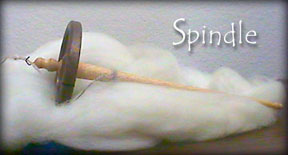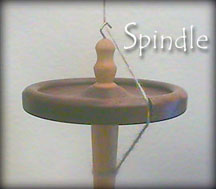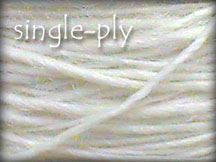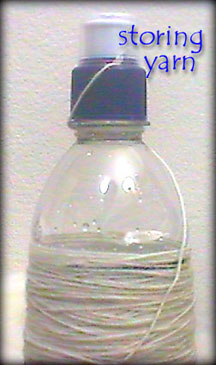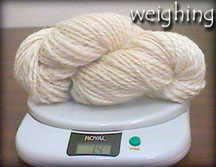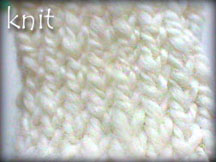|
My yarn starts out as fluffy bits of fiber combed into long strips called
"Rovings". Rovings can be bought from a variety of sources. It is
already clean when I receive it, but sometimes I will find some tiny hay bits! The
picture shows fiber from two different kinds of sheep. I think wool is the most
popular thing to spin, but there are ton of other fibers available: cotton, silk, hemp,
llama, alpaca, and musk ox! Top: White colored Blue-Faced Leicester - silky & easy to spin. Smells a little bit like sheep =) Bottom: Blue dyed Merino - very, very soft but a little harder to spin. Fibers are shorter. |
|
This is my hand spindle (drop spindle) on a pile of Leicester wool. My spindle has a wire hook at the top, so it is called a "top spin spindle". There are many varieties, including the bottom spin and Navajo. |
|
I like my spindle a lot! It weighs 1.6 oz. and is made of walnut and ash woods.
Spindles vary in weight from a few tenths of an ounce to several ounces.
Lighter weight spindles are used to spin thinner, delicate yarns. They would break
under the weight of a heavier spindle! This particular spindle was handmade by
Kundert Wheels in Wisconsin. Close-up of the spindle "whorl" (the disk portion) & the hook. A notch in the whorl allows positioning of the yarn so it lines up with the hook. Attached to the spindle is a "leader" (pre-made string or yarn) which the roving is attached to. |
|
When the roving is attached, I give the spindle a twirl & "draft" (pull
apart) the roving. The fibers become twisted and it makes a single ply yarn.
The yarn is under tension...if I let go, it will fluff up! Twist the yarn onto the
spindle shaft without letting it fluff up. Single ply yarn looks flat & stringy,
it doesn't feel very soft, but that will change =) I usually turn the spindle in the clockwise direction, making a "Z" twist yarn. If the spindle turns counter-clockwise, it makes a "S" twist yarn. Knowing the twist is important in plying. |
|
After the fiber is spun into single-ply yarn, it is wound onto the spindle shaft. When the shaft gets full, I will transfer it to a plastic water bottle. This is a terrific (and cheap) way to store yarn, since I can squish the end under the cap & I don't have to worry about it unwinding! |
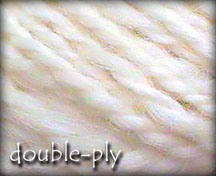 |
The next step is plying (putting multiple single strands together). I usually wait a day or two for the twist to stabilize before plying. Plying also uses the drop spindle. Tie two pieces of yarn together, then put them through the spindle using the REVERSE twist. Since I usually spin my singles clockwise, I will ply turning the spindle counter-clockwise. I try to ply so there is enough twist to hold the two strands together, but not to make it twisty once I let go. This is called a "balanced" yarn and is good to knit or crochet with, because it shouldn't make the piece slant in one direction. |
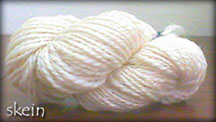 |
Then, the double-stranded yarn is wound into a skein. I tie four loops (in a contrasting shade) around the skein to keep it from unwinding. When I first started out, I used a chair back. Now, I use a tool called a "niddy-noddy" to wind the yarn into the most beautiful skeins =) See my spinning wheel page for a pic of a "niddy". |
|
Next, the yarn is weighed before it gets wet again. Wow! That's a LOT of
work for just 1.4 oz!! Then, it gets a quick wash in warm water & gentle shampoo. Washing in warm water helps to make the twist in the yarn more permanent. Don't overdo it on the washing & rinising, otherwise the wool will felt! =) The yarn is placed on a towel & allowed to dry naturally. |
[pic of tagged skein] |
Finishing touches - I pick a cute name for the yarn and make a little ID tag. Small quantities are wrapped in gift tissue paper & tied gently with ribbon. If I need to store the yarn, it gets placed in a box with a small amount of lavender to protect it from moths. |
|
Here is a sample I knit up from chunky double ply yarn. I'm amazed at how soft this stuff is! I put the sample up to my cheek & I don't feel any scratchiness at all. |
Back to the Fiber Arts Page |
|


